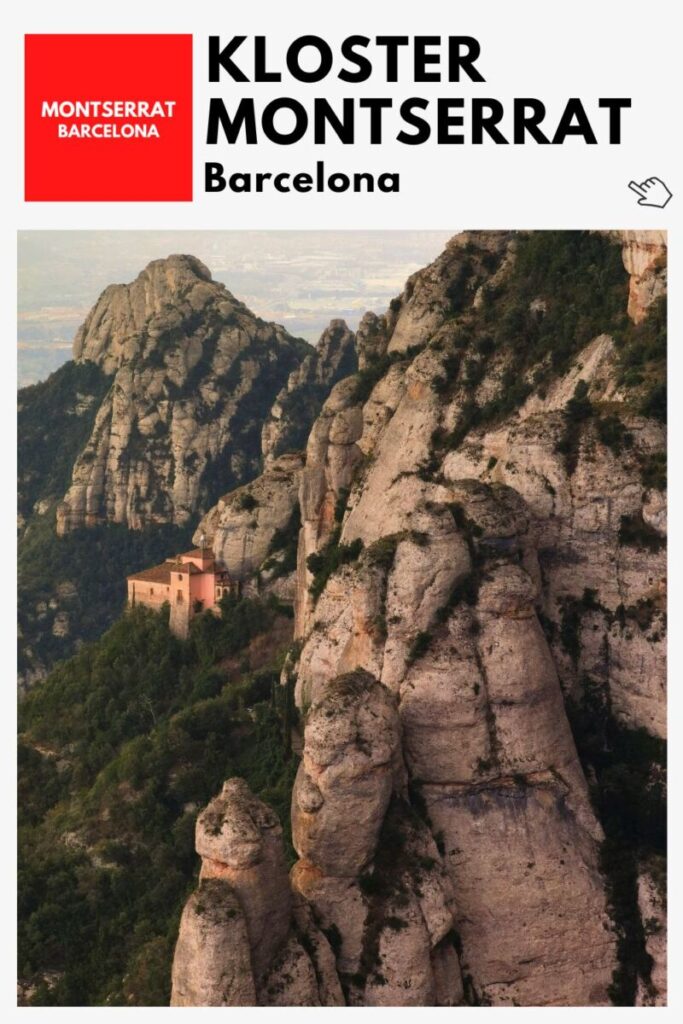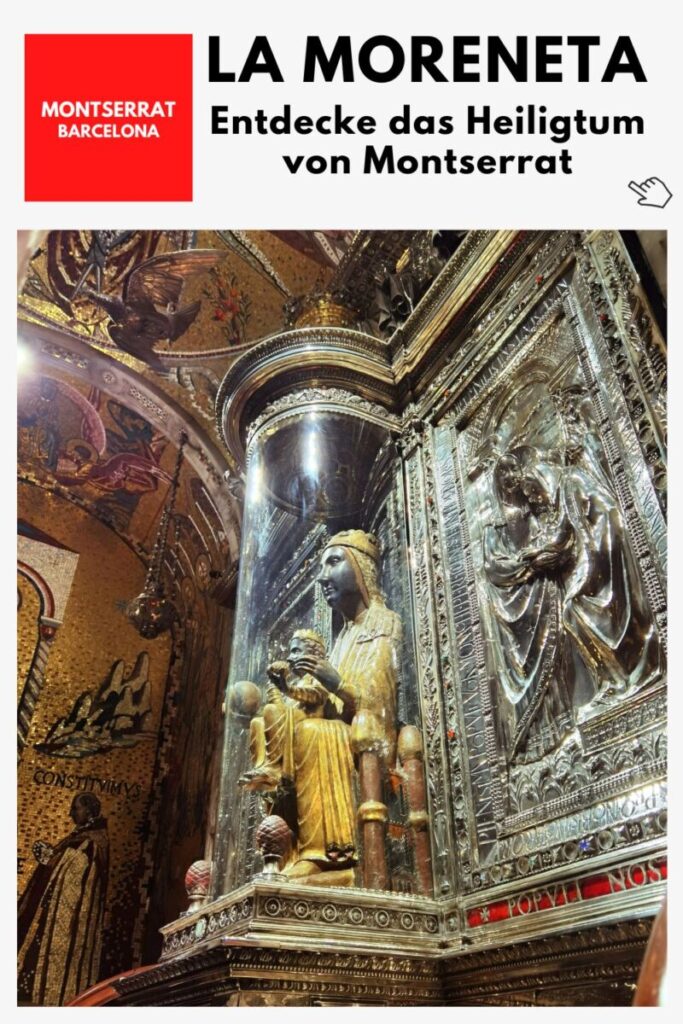Montserrat in Spain
Montserrat is an impressive mountain range in Catalonia, located about 50 kilometers from Barcelona. The jagged peaks of the mountains are a truly remarkable natural wonder. In the heart of these mountains lies the significant Montserrat Monastery. It is a pilgrimage site and a symbol of Catalan culture and independence, making it a popular destination for locals.
In the eastern part of the mountain range lies the Benedictine monastery Santa Maria de Montserrat, famous for its basilica with the Black Madonna and the boys‘ choir l’Escolania. Also well-known is the Stations of the Cross at the monastery, where the famous artist Antoni Gaudí contributed. The monastery is the central building in the entire Montserrat mountain range. From the monastery, well-maintained hiking trails lead to the highest peak. The summit of Sant Jeroni reaches an elevation of 1,236 meters. The region also houses smaller monasteries and hermitages, including the Monastery of Saint Cecilia, which was mentioned as early as the 10th century. The former hermitages were once inhabited but are now abandoned.
To reach the Montserrat monastery, there are hiking trails, a winding road, a cable car since 1930, and a funicular railway, which has been in operation since 2003. A funicular runs from the monastery to the summit of Sant Joan. The flora and fauna are diverse, with a Mediterranean climate prevailing in the area. The vegetation consists mainly of holm oaks, and the fauna includes species such as cliff swallows, squirrels, and wild goats. Montserrat offers numerous hiking and climbing opportunities, including the Via Ferrata Canal de las Damas, a climbing route through a dried-up ravine. Some of the most well-known peaks in the region are Sant Jeroni, Miranda dels Ecos, and Montgròs.
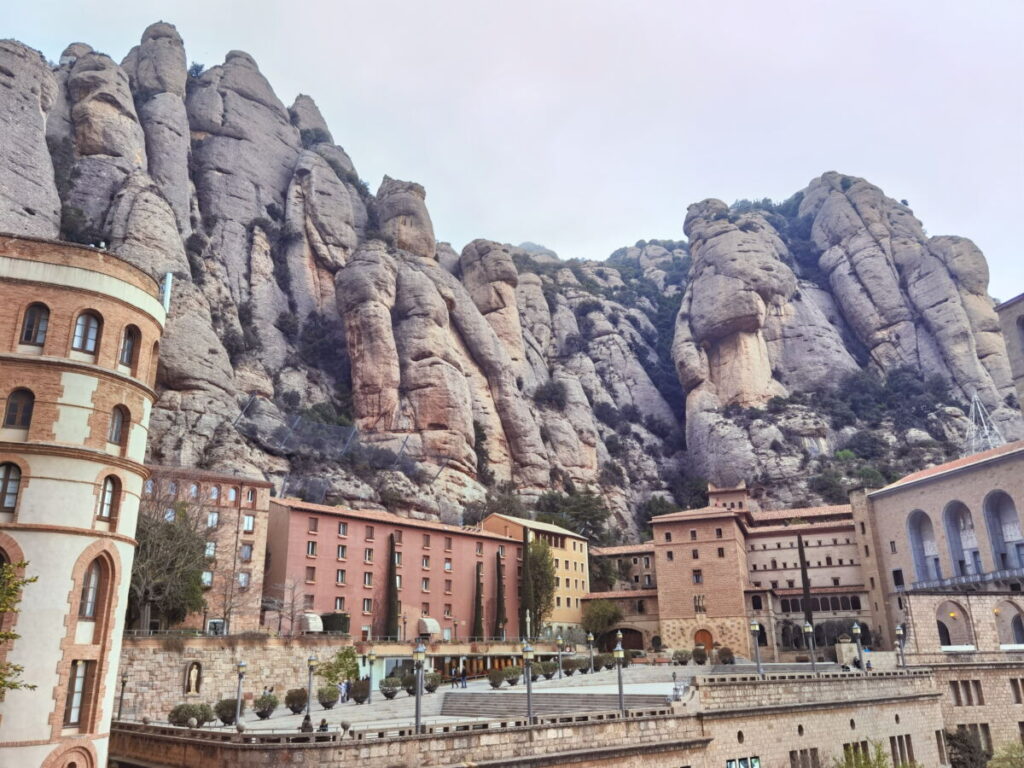
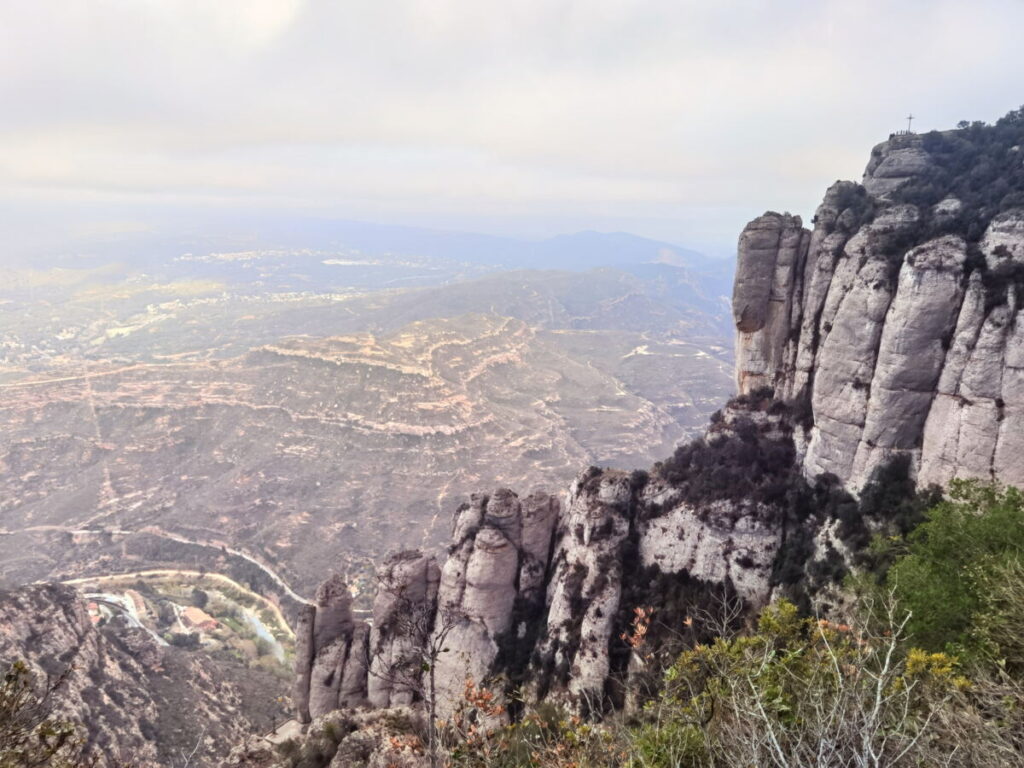
Montserrat mountain Barcelona
Montserrat is a must-see if you’re in Catalonia. It’s a truly unique mountain range in the province of Barcelona, Spain. While many tourists may not yet know these mountains, they hold great significance for the Catalans, due to the monastery and its history: The Montserrat Monastery is a symbol of Catalan independence. It was here that the Catalan language and culture were preserved, even in times when this was officially forbidden. The remote location in the midst of nature played a key role in making this possible.
Today, it is an important pilgrimage site and a fascinating travel destination that particularly impressed us during our visit. The mountain range rises magnificently from the hilly hinterland of the Catalan capital, Barcelona. Although the mountains are only about 50 kilometers from Barcelona, they are not visible from the city, as the Tibidabo mountain range (another great viewpoint in Barcelona) blocks the view. Montserrat extends about 10 kilometers in length and 5 kilometers in width. It is part of the Catalan Pre-coastal Range, also known as the Serralada Prelitoral Catalana. The mountainous area belongs to the municipalities of Collbató, El Bruc, Marganell, and Monistrol de Montserrat.
The Montserrat mountain range is striking: the mountains are very rocky and have a very distinctive shape. The peaks are jagged yet rounded. This form seems to have been taken into account when naming the mountain: “Montserrat” translates from Catalan as “sawed mountain.” The name comes from the distinctive appearance of the rock spires and cliffs. The massif was formed through sedimentation from the Ebro Basin and received its characteristic shape through erosion. It is a unique sandstone mountain range.
Montserrat monastery Spain


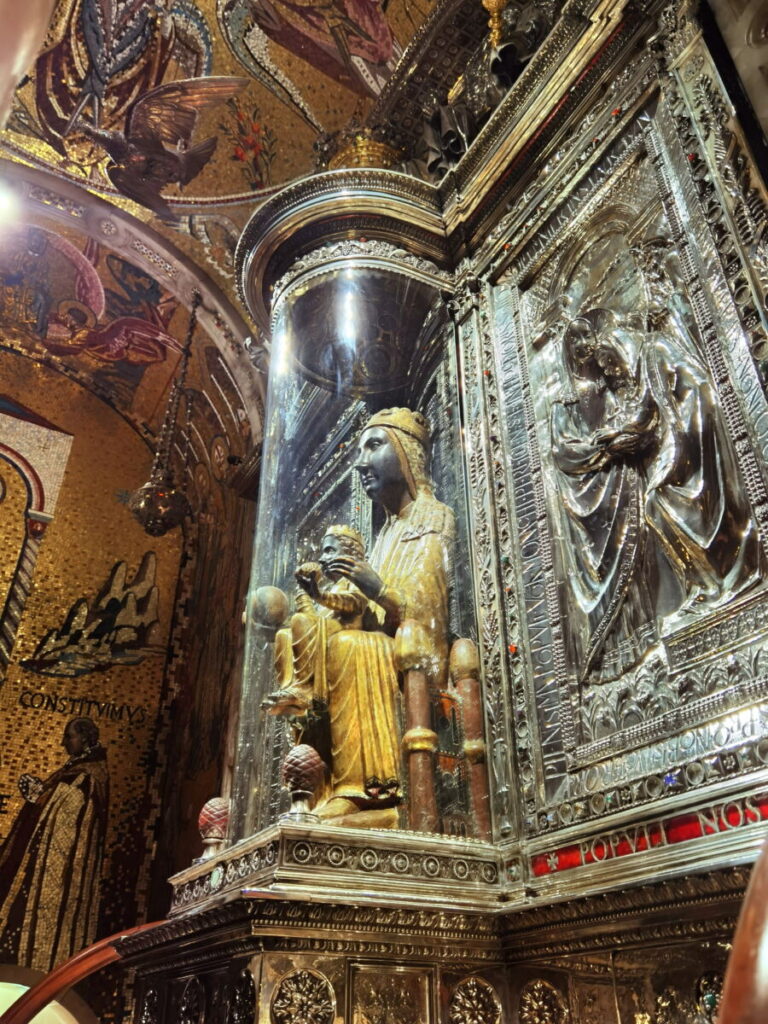
As already mentioned, the main attraction of the entire Montserrat mountain range is the famous rock monastery. The Montserrat Monastery is an important spiritual and cultural center in Catalonia. It is impressively located in the midst of the dramatic mountain massif and is overshadowed by the jagged peaks. Truly spectacular. The monastery is famous for its breathtaking location among the rocks, offering a stunning view of the surrounding landscape.
The monastery houses the statue of the Black Madonna of Montserrat, a special Marian figure that is venerated annually by millions of pilgrims and visitors. This statue is the destination of numerous religious pilgrimages, as it is revered as the patron saint of Catalonia. Unlike other pilgrimage sites, you can view the massive Black Madonna up close—though there is an additional fee for this.
The Montserrat Monastery has a long history that dates back to the 9th century. At that time, hermits began to settle in the caves and rock crevices of the mountain. Over the centuries, the monastery was expanded into a significant spiritual and cultural center, housing a variety of historical buildings, chapels, and works of art.
Today, the Montserrat Monastery is not only a pilgrimage site but also a popular destination for tourists and visitors who wish to experience the impressive landscape, spiritual atmosphere, and rich cultural history of the region. In addition to religious ceremonies and pilgrimages, the monastery also hosts concerts, exhibitions, and cultural events open to the public. A visit is worth it, even if you have no interest in the Catholic Church. The monastery complex felt to us like a small settlement in the mountains. Surrounding the church are numerous buildings offering accommodation, dining, and shopping opportunities.
Black Madonna of Montserrat in Spain
The Black Madonna of Montserrat, also known as “La Moreneta,” is an important religious figure and the patron saint of Catalonia. The statue was created in the 12th century and is made of poplar wood. Legend has it that the Madonna was discovered in a cave by shepherd boys in 880. Visitors can ascend to the Madonna in the church—note the rules and visiting hours.
Montserrat Tickets
Access to the monastery’s attractions, such as the basilica and the Black Madonna, is subject to a fee. There are various ticket packages available. It’s best to book your Montserrat ticket in advance, as due to high demand, not all visit times are available. Here’s an overview of the different tickets that are currently available.
How to get to Montserrat Barcelona?
Montserrat can be reached by car and public transport. Many visitors choose to drive, as it offers flexibility in timing and allows for more freedom during hikes. From Barcelona, Montserrat is easily accessible via the AP-7 highway and then the BP-1121 country road. The last part is a winding mountain road. At the end of the road, you’ll find several parking lots near the monastery. The prices are relatively expensive by Spanish standards.
Although the monastery is located deep in the mountains, it is also easily accessible without a car. A popular option is to take the train from Barcelona to Monistrol de Montserrat. From there, you can take the funicular railway (Cremallera de Montserrat), which takes you directly to the monastery on the mountain. The funicular provides a scenic ride through the mountains and is a favorite transport option for tourists. Alternatively, visitors can take the train from Barcelona to Monistrol de Montserrat and then take the cable car (Funicular Aeri de Montserrat) to the monastery. The cable car also offers spectacular views of the surroundings—but in the off-season, be mindful of limited operating times.
Montserrat Funicular Railway
The Cremallera de Montserrat, the Montserrat funicular, is a very popular means of transportation to reach the Montserrat Monastery effortlessly. You can easily drive to the base station and avoid the last few kilometers up the winding mountain road. For drivers, the funicular offers a convenient option to park your car for free at the Monistrol-Vila train station and then ride the funicular to the monastery stress-free. The funicular is also ideal for train travelers to reach the monastery without effort. The funicular’s base station is easily reachable by the R-5 train from Barcelona. Thus, the funicular provides seamless transport from Barcelona city center to Montserrat Monastery.
Montserrat Cable Car
The Montserrat cable car (Funicular Aeri de Montserrat) is an alternative to the funicular railway to reach the Montserrat Monastery. The base station of the cable car is easily accessible by car, and there are free parking spaces available. For those arriving by train, the cable car offers a convenient transfer option at Monistrol de Montserrat. Many visitors take the train to Monistrol de Montserrat and then take the cable car to the monastery. Please note that the cable car has a different departure point than the funicular. You will need to change trains earlier in Barcelona.
Is Montserrat Worth Visiting? Our Conclusion
We really enjoyed our time at Montserrat. The monastery is an important pilgrimage site and a symbol of Catalan independence. The Montserrat mountain range fascinated us with its jagged and rounded peaks. The Benedictine monastery Santa Maria de Montserrat, famous for the Black Madonna and the boys’ choir l’Escolania, is definitely worth visiting. If you enjoy hiking, you should explore the trails around the rock monastery. You can hike from the monastery to the highest peak, Sant Jeroni. We were particularly impressed by the journey to Montserrat: it’s easily accessible by car, train, funicular, or cable car. The funicular and cable car rides offer spectacular views and are a highlight in themselves. Overall, Montserrat is not only a spiritual and cultural center but also a fascinating travel destination. It is a wonderful day trip just outside Barcelona, and its breathtaking landscape truly impressed us. A visit is definitely worth it, whether you’re interested in the religious aspects or simply want to enjoy the beauty of nature. It’s best to take your time and not just do a day trip. There are accommodations in the monastery complex. When the last trains run in the evening, it becomes wonderfully quiet, and you can discover the unique charm of the area.
Weiterführende Links für deinen Ausflug
- alle Informationen über Montserrat Barcelona
- wissenswert über das Kloster Montserrat
- die Alternative: die Montserrat Zahnradbahn
- die aktuellen Kloster Montserrat Preise
- hier kannst du am Kloster Montserrat parken
- beachte die Montserrat Öffnungszeiten
Faq about Montserrat Spain
Montserrat in Spain is a Benedictine monastery located in the mountains of the same name in Catalonia, about 40 km northwest of Barcelona. It is also the name of the mountain on which the monastery sits. The monastery, officially called Santa Maria de Montserrat, is an important spiritual and cultural center that attracts thousands of pilgrims and tourists each year.
Yes, the Montserrat Monastery is open to visitors. It is an open spiritual and cultural center that welcomes pilgrims, tourists, and travelers from around the world. Visitors can tour the monastery, enter the church, venerate the Black Madonna, attend services, and explore the surrounding areas.
The Montserrat Mountains are an impressive mountain range in Catalonia, Spain. Located about 40 kilometers northwest of Barcelona, they are known for their distinctive rock formations and steep cliffs. The name “Montserrat” comes from the Catalan word for “sawed mountain,” referring to the rough and irregular profile of the mountain range.
Yes, hiking is definitely possible in Montserrat. The region offers a variety of hiking trails that lead through the stunning landscape of the Montserrat Mountains. These trails cater to both experienced hikers and beginners and allow visitors to enjoy the natural beauty and breathtaking views of the area.
Some of the most popular hiking destinations in Montserrat include:
– Sant Jeroni: This is the highest peak in the Montserrat Mountains and offers panoramic views of the surrounding landscape. The hike to Sant Jeroni is challenging, but the view from the top is worth the effort.
– Sant Joan: Another popular peak, lower than Sant Jeroni but still offering spectacular views. The hike to Sant Joan is less strenuous and suitable for all ages.
– Hermitages and Chapels: There are several hermitages and chapels around Montserrat that can be reached via well-marked trails. These historic sites offer a glimpse into the region’s religious history, along with beautiful views and peaceful spots to relax.
It’s recommended to bring proper hiking gear, including sturdy footwear, water, sun protection, and a hiking map before embarking on a hike in Montserrat.

